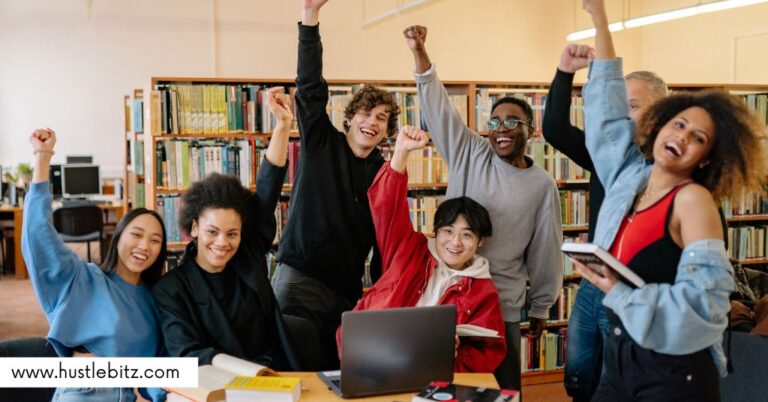Peer influence is a crucial factor in shaping social motivation, especially during adolescence when individuals are particularly sensitive to peer relationships. Peer groups establish social norms that impact motivations and behaviors, promoting either positive or negative outcomes. Positive peer influence can encourage beneficial behaviors and academic success, while negative influence may lead to risky choices and disengagement. Understanding the distinction between peer support and pressure is vital for healthy development. By exploring these dynamics, one can gain insights into enhancing motivation and resilience within social settings. More on effective strategies to harness these influences awaits your curiosity.
Key Takeaways
- Peer influence significantly shapes social motivation, especially during adolescence, by providing validation and assisting in identity formation.
- Positive peer interactions foster supportive environments that enhance academic achievement and collective motivation through reinforced social norms.
- Negative peer influence can lead to risky behaviors and disengagement, undermining individual motivation and personal goals.
- Peer support enhances resilience and constructive behaviors, promoting mental health and physical fitness among individuals.
- Establishing realistic goals and celebrating small wins within peer groups can transform challenges into successes and sustain motivation.

Peer Influence: A Key Factor in Social Motivation

Peer influence serves as a pivotal catalyst in shaping individuals’ social motivation, driving behaviors and attitudes within group contexts. This phenomenon is especially pronounced during adolescence, a developmental stage characterized by heightened sensitivity to peer relationships. Within a social context, adolescents often look to their peer groups for validation and identity formation, which significantly impacts their motivation levels.
Positive peer influence plays a crucial role in fostering a sense of belonging among adolescents. When individuals feel accepted and supported by their peers, they are more likely to engage in behaviors that promote academic achievement and healthy social bonds. For instance, a peer group that prioritizes educational success can motivate its members to adopt similar values, thus enhancing their drive to excel academically.
Conversely, negative peer influence may lead to detrimental behaviors, highlighting the complexities of peer dynamics. The desire to fit in can push adolescents towards choices that may conflict with their personal goals. Therefore, the nature of peer relationships becomes critical in determining the overall direction of an individual’s social motivation.
Understanding the impact of peer influence is essential for parents, educators, and policymakers alike. By fostering environments that encourage positive peer interactions, we can enhance adolescents’ social motivation, thereby improving their overall well-being and academic outcomes.
Ultimately, the quality of social bonds formed within peer groups significantly influences the trajectory of young individuals as they navigate the challenges of adolescence.
How Peer Groups Shape Individual Motivation and Behavior

The influence of peer groups significantly shapes individual motivation and behavior by establishing social norms and expectations that individuals often feel compelled to adopt. These social norms dictate acceptable behaviors and attitudes, thereby influencing individual motivation in various contexts, including academic settings and social interactions. Peer influence plays a crucial role in fostering social motivation, as individuals seek to align their behaviors with those of their peers to maintain relationships and fulfill their need for social connection.
Positive influences from peer groups can enhance individual motivation, particularly in academic functioning. When individuals observe their peers engaging in productive study habits or participating in extracurricular activities, they may feel motivated to emulate these behaviors, thereby improving their own academic performance. Conversely, negative peer interactions can lead to decreased motivation and disengagement from important tasks, further illustrating the dual nature of peer influence.
Relationships with peers are instrumental in shaping not only individual motivation but also behavior. Individuals often gauge their actions and aspirations based on the behaviors exhibited by their peers. This dynamic can create an environment where social norms are reinforced, leading to a collective motivation within the group.
Ultimately, the interplay between peer influence and individual motivation underscores the importance of understanding how peer groups shape behavior. Recognizing these influences allows individuals to navigate their social landscapes effectively, fostering environments that promote positive motivation and healthy relationships.
Impact of Positive Peer Influence on Social Motivation
Positive peer influence significantly enhances social motivation by encouraging individuals to adopt constructive behaviors and attitudes that align with group norms. This dynamic is particularly pronounced among adolescents, who are often highly attuned to the opinions and behaviors of their peers. When positive peer influence is present, individuals are more likely to engage in activities that foster peer acceptance and reinforce their social networks.
In educational settings, positive peer interactions can markedly boost student motivation. For instance, when students support one another academically and socially, they create an encouraging environment that promotes learning and collaboration. Peer support mechanisms—such as study groups or extracurricular activities—enhance social experiences, making individuals feel valued and connected. This sense of belonging can lead to heightened levels of engagement and perseverance in academic pursuits.
Moreover, the importance of peers in shaping social motivation cannot be overstated. Positive peer influence provides a framework where individuals can share goals and aspirations, thereby fostering a collective motivation that benefits all members of the group. As adolescents witness their peers striving for success, they often feel inspired to mirror those behaviors, reinforcing a cycle of motivation and achievement.
Peer Pressure vs. Peer Support: Navigating Social Motivation
Navigating the complex dynamics of social motivation requires distinguishing between peer pressure and peer support, both of which significantly influence individual behavior and attitudes within group contexts.
Peer pressure often manifests as a social influence that compels adolescents to conform to group norms, sometimes leading to detrimental outcomes such as risky behaviors or decreased academic motivation. This phenomenon arises from the intense need to belong and be accepted within peer relations, which can overshadow personal values and goals.
Conversely, peer support emerges as a positive form of social influence, fostering resilience and encouraging constructive behaviors. Supportive peers can enhance social connections, providing the encouragement necessary for individuals to pursue their academic aspirations and develop a strong sense of self. This supportive environment promotes healthy development, allowing adolescents to thrive both socially and academically.
The interplay between peer pressure and peer support illustrates the complexity of social motivation. While some adolescents may struggle with resistance to peer pressure, others may find strength in peer support networks that bolster their confidence and motivation.
Understanding these dynamics is crucial for educators, parents, and peers who aim to cultivate environments that prioritize healthy social connections and positive influences. By recognizing the significance of both peer pressure and peer support, stakeholders can better equip adolescents to navigate the challenges of social influence, ultimately fostering a more conducive atmosphere for personal and academic growth.
Harnessing Mental Resilience to Boost Physical Fitness

Harnessing mental resilience is essential for individuals seeking to enhance their physical fitness and overall well-being. Mental resilience allows individuals, particularly adolescents, to withstand challenges and setbacks, fostering a greater commitment to their fitness goals. Peer influence plays a significant role in shaping this resilience, as social motivation can inspire individuals to push through difficulties and adhere to group norms that promote physical activity.
To effectively harness mental resilience for improved physical fitness, consider the following strategies:
- Cultivate Intrinsic Motivation: Engage in activities that resonate personally rather than solely for external approval. This fosters a deeper connection to fitness pursuits.
- Leverage Peer Groups: Surround yourself with supportive peers who share similar fitness goals. Social interaction within these groups can enhance motivation and accountability.
- Set Realistic Goals: Establish achievable fitness objectives that encourage a sense of accomplishment. This builds confidence and fortifies mental resilience.
- Embrace Challenges: View setbacks as opportunities for growth. A resilient mindset transforms obstacles into stepping stones, reinforcing commitment to physical fitness.
Creating a Fitness Routine That Aligns with Your Mindset

Developing a fitness routine that aligns with your mindset is crucial for sustaining motivation and achieving long-term health goals. Understanding the role of social motivation, especially during adolescence, can significantly enhance this process. Adolescents are particularly influenced by their peers; thus, navigating peer dynamics can impact their fitness choices. When students engage in fitness activities alongside friends, they are more likely to feel motivated due to the social rewards associated with group influences.
The importance of peer groups cannot be overstated; they often serve as a benchmark for social comparison, which can either encourage or hinder an individual’s commitment to a fitness routine. For instance, positive reinforcement from peers can enhance students’ motivation by fostering a sense of belonging and accountability. Conversely, negative comparisons may dissuade individuals from pursuing their health goals, highlighting the need for a supportive environment.
To create an effective fitness routine, individuals should consider their personal preferences and mindset while also being mindful of the impact of social dynamics. Engaging in activities that resonate with one’s interests, while involving friends or peers, can amplify motivation. This alignment fosters a sense of community and shared purpose, further reinforcing the commitment to fitness.
Ultimately, recognizing the interplay between mindset and social influences is essential for developing a sustainable fitness routine that not only meets personal health goals but also nurtures social connections.
Transforming Fitness Challenges into Motivational Wins

Transforming fitness challenges into motivational wins requires a strategic approach that celebrates small successes and fosters resilience in the face of obstacles.
The role of peer influence is critical in this process, as peer group dynamics can significantly shape students’ motivation and engagement in fitness activities. By leveraging social motivation, individuals can navigate peer relationships and enhance their fitness journey.
Here are four key strategies to consider:
- Set Incremental Goals: Establish small, achievable fitness objectives that provide a sense of accomplishment. This aligns with self-determination theory, emphasizing the importance of competency in motivation.
- Create Accountability: Form peer groups that encourage social evaluation, where members share their progress and challenges. This not only fosters positive peer group influences but also helps mitigate negative pressures from social situations.
- Celebrate Achievements: Recognize and celebrate each milestone, no matter how minor. This not only boosts individual confidence but also reinforces a supportive network that values collective success.
- Utilize Social Network Analysis: Assess how peer interactions can enhance or hinder motivation. Understanding these dynamics can help individuals cultivate a more supportive fitness environment.
Final Thoughts
Understanding the role of peer influence in social motivation is essential for navigating the complexities of relationships, especially during adolescence. Positive peer interactions can significantly enhance motivation and encourage healthy behaviors, while negative influences can lead to detrimental outcomes. By fostering supportive peer environments and recognizing the impact of both peer pressure and support, individuals can better harness social motivation to achieve personal and academic success. The key lies in cultivating resilience, setting realistic goals, and leveraging the power of positive peer influence to transform challenges into opportunities for growth.




